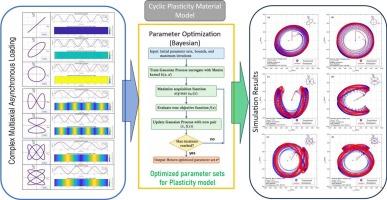Constitutive modeling and experimental analysis of asynchronous multiaxial fatigue in 304LN stainless steel using Bayesian optimization
IF 6.8
2区 材料科学
Q1 ENGINEERING, MECHANICAL
引用次数: 0
Abstract
This study proposes a computational framework for modeling the multiaxial cyclic plasticity behavior of 304LN stainless steel under both synchronous and asynchronous strain-controlled loading. A series of biaxial fatigue experiments on thin-walled tubular specimens revealed pronounced nonproportional hardening and path-dependent plastic deformation, particularly under asynchronous loading conditions. To capture these effects, an advanced constitutive model was formulated by integrating multi-component kinematic hardening, a memory-dependent isotropic hardening rule, and a nonproportionality-sensitive internal variable. Model calibration was carried out using Bayesian Optimization, with kinematic hardening parameters trained on eighteen uniaxial hysteresis loops representative of various cyclic conditions to enhance the accuracy of simulated loop shapes. The finalized model was implemented in a finite element framework and validated across seven multiaxial loading paths. Simulations demonstrated high fidelity in reproducing hysteresis loop shapes, peak stresses, strain ranges, and stress path trajectories. Qualitative analysis indicates that asynchronous multiaxial loading in 304LN stainless steel results in elevated plastic strain accumulation and significant nonproportional hardening, effects that are closely associated with the newly introduced Desynchrony Index (DI). Experimental observations further demonstrate that asynchronous loading paths can produce cyclic hardening comparable to, or exceeding, that of classical out-of-phase loading, underscoring the importance of time-varying phase interactions in cyclic plasticity. The evolution of the nonproportionality parameter also shows strong agreement with experimentally derived desynchrony indices, reinforcing the robustness of the proposed approach for fatigue analysis under complex multiaxial loading conditions.

基于贝叶斯优化的304LN不锈钢异步多轴疲劳本构建模与试验分析
本研究提出了一种模拟304LN不锈钢在同步和异步应变控制加载下多轴循环塑性行为的计算框架。对薄壁管状试件进行的一系列双轴疲劳试验表明,在异步加载条件下,其非比例硬化和路径依赖的塑性变形尤为明显。为了捕捉这些影响,通过整合多分量运动硬化、记忆相关的各向同性硬化规则和非比例敏感的内部变量,建立了一个先进的本构模型。采用贝叶斯优化方法对模型进行标定,并对代表不同循环条件的18条单轴滞回线进行运动学硬化参数训练,以提高模拟回路形状的精度。最终的模型在一个有限元框架中实现,并在七个多轴加载路径上进行了验证。仿真结果表明,在再现迟滞回路形状、峰值应力、应变范围和应力路径轨迹方面具有高保真度。定性分析表明,304LN不锈钢的异步多轴加载导致塑性应变积累增加和显著的非比例硬化,这些效应与新引入的非同步指数(DI)密切相关。实验观察进一步表明,异步加载路径可以产生与经典的非相加载相当或超过的循环硬化,强调了时变相相互作用在循环塑性中的重要性。非比例参数的演化也显示出与实验推导的非同步指标的强烈一致性,增强了所提出的方法在复杂多轴载荷条件下进行疲劳分析的鲁棒性。
本文章由计算机程序翻译,如有差异,请以英文原文为准。
求助全文
约1分钟内获得全文
求助全文
来源期刊

International Journal of Fatigue
工程技术-材料科学:综合
CiteScore
10.70
自引率
21.70%
发文量
619
审稿时长
58 days
期刊介绍:
Typical subjects discussed in International Journal of Fatigue address:
Novel fatigue testing and characterization methods (new kinds of fatigue tests, critical evaluation of existing methods, in situ measurement of fatigue degradation, non-contact field measurements)
Multiaxial fatigue and complex loading effects of materials and structures, exploring state-of-the-art concepts in degradation under cyclic loading
Fatigue in the very high cycle regime, including failure mode transitions from surface to subsurface, effects of surface treatment, processing, and loading conditions
Modeling (including degradation processes and related driving forces, multiscale/multi-resolution methods, computational hierarchical and concurrent methods for coupled component and material responses, novel methods for notch root analysis, fracture mechanics, damage mechanics, crack growth kinetics, life prediction and durability, and prediction of stochastic fatigue behavior reflecting microstructure and service conditions)
Models for early stages of fatigue crack formation and growth that explicitly consider microstructure and relevant materials science aspects
Understanding the influence or manufacturing and processing route on fatigue degradation, and embedding this understanding in more predictive schemes for mitigation and design against fatigue
Prognosis and damage state awareness (including sensors, monitoring, methodology, interactive control, accelerated methods, data interpretation)
Applications of technologies associated with fatigue and their implications for structural integrity and reliability. This includes issues related to design, operation and maintenance, i.e., life cycle engineering
Smart materials and structures that can sense and mitigate fatigue degradation
Fatigue of devices and structures at small scales, including effects of process route and surfaces/interfaces.
 求助内容:
求助内容: 应助结果提醒方式:
应助结果提醒方式:


